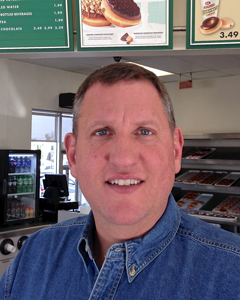
In Southern California, a region that has been called the doughnut capital of the country, shops serving the sweet breakfast treat are on the rise.
Krispy Kreme Doughnuts Inc. announced last week that its Southern California franchisee, Great Circle Family Foods, plans to open 20 shops in the area in the next seven years.
Great Circle, Krispy Kreme’s first big franchisee west of the Mississippi River, owns and operates 11 stores in Southern California. The Long Beach operator signed an exclusive development agreement with the Winston-Salem, N.C., parent company to open stores in the seven southernmost counties of California, including Ventura, Los Angeles and San Bernardino.
Roger Glickman, chief executive for Great Circle, said it’s too soon to know yet exactly where the stores will open.
“Twenty stores is a number that will allow us to bring the Krispy Kreme doughnut experience to as many people as possible without cannibalizing our own business,” he said. “We would expect to open these stores all over, with more density of stores where there’s greater density of population.”
The new stores will be smaller and less expensive to develop than previous outlets have been, though customers will still be able to watch their doughnuts be made in a small “factory” on site.
News of the franchisee’s expansion comes about a year after Canton, Mass., chain Dunkin’ Donuts announced it would open 150 stores in Southern California beginning in 2015.
Nick Setyan, an analyst who covers Krispy Kreme for the downtown L.A. office of Wedbush Securities Inc., said he doesn’t think Dunkin’ Donuts will pose much of a competitive threat to Krispy Kreme because, although both sell doughnuts, the two chains have divergent business models.
“I think of Dunkin’ Donuts as more of a coffee company, in line with Starbucks and McDonald’s,” he said. “At Krispy Kreme, average customers go in once every 30 days and buy two dozen doughnuts. At Dunkin’ Donuts, they go in once every one-and-a-half days and buy a coffee and maybe a doughnut or a sandwich to go with it. Doughnuts are 90 percent of Krispy Kreme’s sales and for Dunkin’ Donuts they’re only about 10 percent.”
Krispy Kreme, which had 812 mostly franchised stores in 23 countries as of Sept. 30, has set a companywide goal to have a total of 900 international stores and 400 domestic stores by the end of 2017.
Recovery mode
Great Circle’s commitment to expand by 20 stores in Southern California reflects a return to good fortune that the company has been nurturing for the last five years.
Though Great Circle initially had a lot of success opening Krispy Kreme stores in early 2000s – at its peak the franchisee operated 30 stores – it began to run into trouble when its public parent company lost favor on Wall Street.
The doughnut company, which saw its stock peak at $49.37 in 2003, fell victim to overly aggressive growth expectations and its stock plummeted to less than $6 by the end of 2005. Great Circle sued Krispy Kreme that year, claiming the company was trying to force the franchisee into bankruptcy, made false representations, inflated prices and engaged in deceptive business practices. The two parties settled the dispute nearly a year later, but Great Circle still ended up filing for bankruptcy reorganization in 2008.
Since coming out of bankruptcy in 2009, Glickman said Great Circle has fared much better.
“In the past several years, we have found enormous success in terms of sales growth and profitability,” he said. “We’ve gotten to know the brand in the context of Southern California very well.”
In its last quarterly filing, Krispy Kreme reported net income of $11.2 million, compared with $8.3 million in the same period a year earlier. Revenue rose to $114 million, with same stores sales up 3.7 percent, a 20th consecutive quarterly increase.
Conrad Lyon, a restaurant industry consultant in Calabasas who covered Krispy Kreme as an analyst in its heyday, said Great Circle has a lot of good things going for it as it tries to expand this time around. Perhaps most important, he said, is the fact that Krispy Kreme has put a new management team in place over the last several years.
“The management team that was around in the early to mid-2000s was not an honest team,” he said. “Since then, a new team was put in place and has been running things a lot better. The new team is much more supportive (of franchisees).”
The Krispy Kreme corporate management team, led by Chief Executive James Morgan, has made some changes that Glickman said will have a positive impact on his business. About a year ago, the company began testing a smaller footprint for its stores. Now, instead of spending $2 million to open a 4,500-square-foot location, franchisees can open a 2,200-square-foot store for as little as $500,000.
“In the past we had a lot of excess capacity, which meant excess capital investment and operating expenses as well,” Glickman said. “We think the smaller factory store gives us just the right amount of capacity to meet the retail demand for the store.”
Lyon said Krispy Kreme has also pulled back on its wholesale efforts in recent years, which often undercut the business of franchisees.
“Now corporate, if they have a franchisee ready to open stores in a new territory where there are already wholesale operations, the company will shut down the wholesale business so the franchisee will be successful,” he said. “It’s not just a nice gesture; it’s a smart thing to do to ensure the success of the franchisee.”
